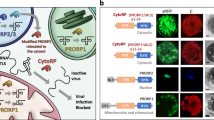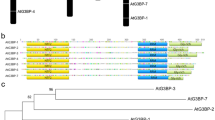Abstract
A recombinant cauliflower mosaic virus (Ca-MTII) was constructed by inserting a cDNA clone of Chinese hamster metallothionein II into the open reading frame II of the cloned virus pCa-BB1. Systemically-infected Brassica campestris tissue contained metallothionein at a level of 0.5 percent of the soluble leaf protein. This efficient expression conferred four times the Cd-binding capacity when compared with Ca-BB1 infected leaves. Ca-MTII-infected leaves exposed to 1 mM CdCl2 bound all the free Cd whereas uninfected leaves possessed 43.8 nmol free Cd per milligram of protein. This may be responible for Cd resistance in the Ca-MTII plant cells. Metallothionein is the first mammalian gene product shown to be functional in plants.
This is a preview of subscription content, access via your institution
Access options
Subscribe to this journal
Receive 12 print issues and online access
$209.00 per year
only $17.42 per issue
Buy this article
- Purchase on Springer Link
- Instant access to full article PDF
Prices may be subject to local taxes which are calculated during checkout
Similar content being viewed by others
References
Kagai, J.H.R. and Nordberg, M. 1979. Metallothionein. Brikhaüser-Verlag, Basel.
Nielson, K.B., Atkin, C.L. and Winge, D.R. 1985. Distinct metal-binding configurations in metallothionein. J. Biol. Chem. 260: 5342–5350.
Beach, L.R. and Palmiter, R.D. 1981. Amplification of the metallothionein-I gene in cadmium resistant mouse cells. Proc. Natl. Acad. Sci. USA 78: 2110–2114.
Karin, M., Cathala, G. and Nguyen-Huu, M. 1983. Expression and regulation of a human metallothionein gene carried on an autonomously replicating shuttle vector. Proc. Natl. Acad. Sci. USA 80: 4040–4044.
Grill, E., Winnacker, E.-L. and Zenk, M.H. 1985. Phytochelatins: The principal heavy-metal complexing peptides of higher plants. Science 230: 674–676.
Rauser, W.E. 1986. The amount of cadmium associated with Cd-binding protein in roots of Agrostis gigantea, maize, and tomato. Plant Science 43: 85–91.
Van Bruwaene, R., Kirchmann, R. and Impens, R. 1984. Cadmium contamination in agriculture and zootechnology. Experientia 40: 43–51.
Sherlock, J.C. 1984. Cadmium in foods and the diet. Experientia 40: 152–156.
Brisson, N. and Hohn, T. 1986. Plant virus vectors: cauliflower mosaic virus. Methods Enzymol. 118: 659–668.
Griffith, B.B., Walter, R.A., Enger, M.D., Hildebrand, C.E. and Griffith, J.K. 1983. cDNA cloning and nucleotide sequence comparison of Chinese hamster metallothionein I and II in RNAs. Nucleic Acids Res. 11: 901–910.
Vander Maillie, R.J. and Garvey, J.S. 1979. Radioimmunoasays of metallothioneins. J. Biol. Chem. 254: 8416–8421.
Cherian, M.G., Nouttainiemi, I. and Nordberg, M. 1983. Comparison of tissue distribution of cadmium in mice intravenously injected with metallothionein and a polymer of metallothionein. Toxicology 26: 161–171.
Hamer, D.H. 1986. Metallothionein. Ann. Rev. Biochem. 55: 913–951.
Hull, R. and Covey, S.N. 1985. Cauliflower mosaic virus: pathways of infection. BioEssays 2: 160–163.
Deblock, M., Herrera-Estrejla, L., Van Montagu, M., Schell, J. and Zambryski, P. 1984. Expression of foreign genes in regenerated plants and in their progeny. EMBO J. 3: 1681–1689.
Herrera-Estrella, L., Depicker, A., Van Montagu, M. and Schell, J. 1983. Expression of chimaeric genes transferred into plant cells using a Ti-plasmid-derived vector. Nature 303: 209–213.
Casterline, J.L. and Barnett, N.M. 1982. Cadmium-binding components in soybean plants. Plant Physiol. 69: 1004–1007.
Rauser, W.E. 1984. Isolation and partial purification of cadmium-binding protein from roots of the grass Agrostis gigantea. Plant Physiol. 74: 1025–1029.
Brisson, N., Paszkowski, J., Penswick, J.R., Gronenborn, B., Potrykus, I. and Hohn, T. 1984. Expression of a bacterial gene in plants by using a viral vector. Nature 310: 511–514.
French, R., Janda, Mi and Ahlquist, P. 1986. Bacterial gene inserted in an engineered RNA virus: efficient expression in monocotyledonous plant cells. Science 231: 1294–1297.
Galun, E. 1981. Plant protoplasts as physiological tools. Ann. Rev. Plant Physiol. 32: 237–266.
Schell, J. and Van Montagu, M. 1983. The Ti plasmids as natural and as practical gene vectors for plants. Bio/Technology 1: 175–180.
Potrykus, I., Shillito, R.D., Saul, M.W. and Paszkowski, J. 1985. Direct gene transfer: state of the art and future potential. Plant Molec. Biol. Rep. 3: 117–128.
Reich, T.J., Iyer, V.N., Scobie, B. and Miki, B. 1986. A detailed procedure for the intranuclear microinjection of plant protoplasts. Can. J. Bot. 64: 1255–1258.
Howell, S.H., Walker, L.L. and Dudley, R.K. 1980. Cloned cauliflower mosaic virus DNA infects turnips (Brassica rapa). Science 208: 1265–1267.
Gardner, R.C. and Shepherd, R.J. 1980. A procedure for rapid isolation and analysis of cauliflower mosaic virus DNA. Virology 106: 159–161.
Maniatis, C., Fritsch, E.F. and Sambrook, J. 1982. Molecular cloning, a Laboratory Manual. Cold Spring Laboratory, Cold Spring Harbor, N.Y.
McGinnis, W., Garber, R.L., Wirz, J., Kuroiwa, A. and Gehring, W.J. 1984. A homologous protein-coding sequence in Drosophila homeotic genes and its conservation in other metazoans. Cell 37: 403–408.
Weinstock, R., Sweet, R., Weiss, M., Cedar, H. and Axel, R. 1978. Intragenic DNA spacers interrupt the ovalbumin gene. Proc. Natl. Acad. Sci. USA 75: 1299–1303.
Brower, M.S., Brakel, C.L. and Garry, K. 1985. Immunodetection with streptavidin-acid phosphate complex on western blots. Anal. Biochem. 147: 382–386.
Lowry, O.H., Rosenbrough, N.J., Farr, A.L. and Randall, R.J. 1951. Protein measurement with the Folin phenol reagent. J. Biol. Chem. 193: 265–275.
Author information
Authors and Affiliations
Rights and permissions
About this article
Cite this article
Lefebvre, D., Miki, B. & Laliberté, JF. Mammalian Metallothionein Functions in Plants. Nat Biotechnol 5, 1053–1056 (1987). https://doi.org/10.1038/nbt1087-1053
Received:
Accepted:
Issue Date:
DOI: https://doi.org/10.1038/nbt1087-1053



